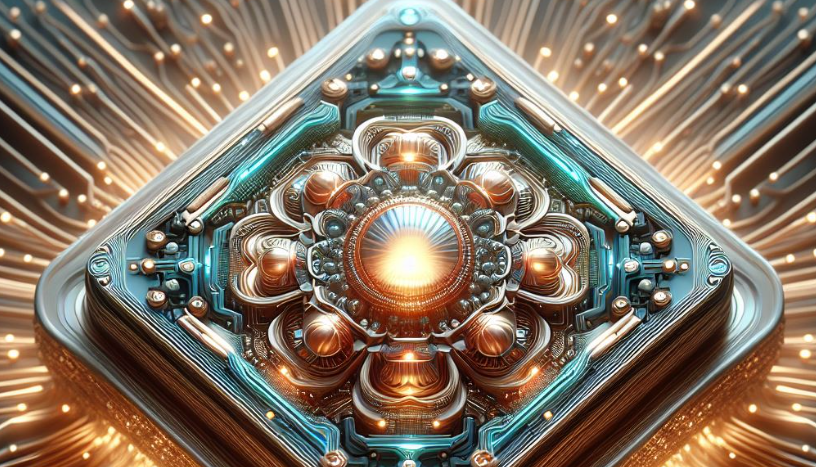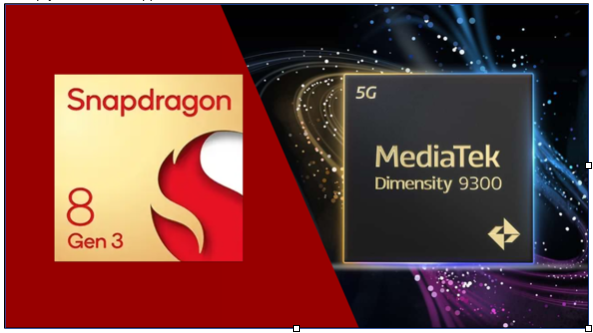Browsing and scrolling through social media reels is fine, but can your current smartphone handle ultra-high fps gaming? Competitive gaming is not a joke! It requires serious hardware to stay on top. PUBG, Fortnite, Call of Duty, League of Legends, and Dota 2 are just some of the games that lead smartphone manufacturers to push the limit of mobile graphics through a single SoC (System-on-a-Chip).
The recent addition to the mighty gaming chipsets from Qualcomm and MediaTek are Snapdragon 8 Gen 3 and Dimensity 9300, respectively. Explore them and check out the best gaming smartphones 2024 using these top-of-the-line flagship SoCs in our guide. This guide will also cover answers to questions like what makes a chipset good for gaming, which is the best for your requirements, and how they stand in head-to-head benchmarks.

Let's begin with a short guide for our readers so they know what to look for in the blog.
Short Guide
Match Your Playstyle to the Chipset:
Like in any technology, developers optimize games with specific chipsets in mind. PUBG performs better on Apple chipsets than SD (Snapdragon) or Dimensity SoCs. Always look for in-game benchmarks for different smartphones to make an educated purchasing decision.
Competitive Esports vs. Casual Adventures:
Competitive games are optimized to work better on all devices across platforms, operating systems, devices, and chipsets. They intend to provide fast-paced gaming performance like in MOBA (Multiplayer Online Battle Arena) and FPS (first-person shooter) genre games. In contrast, casual games like Genshin Impact and Black Desert Mobile are all about visuals and tend to be more demanding.
Consider Price/Performance Ratio:
Gamers' most crucial decision-making factor. While premium features such as a dedicated internal cooling fan and air triggers can disrupt the ratio, specs like SoC chipset and display technology remain in the price/performance race. Simply select your most important parameters and score your best gaming smartphones. Divide its price by the score, and you will have your own price/performance ratio. Welcome Spreadsheets!
1. What are Qualcomm and MediaTek?
Many SoC manufacturers exist, but Qualcomm and MediaTek lead the Android smartphone category due to their exceptional performance and price. Currently, both utilize the latest 4nm lithography to produce their processors. Let's see what made them the best chipset for gaming smartphones:
1.1 Qualcomm: Snapdragon Mobile Processors
An American manufacturer founded in July 1985 produces mobile smartphone processors in the budget-friendly category (400 Series) to premium grade (Snapdragon 8 Gen 3) for flagship phones. Most modern developers optimize their games for SD due to the widespread use of SD processors in the gaming smartphone industry.
1.2 MediaTek: Dimensity Mobile Processors
Born in 1997, the Taiwanese company “MediaTek” targeted budget-friendly phones. Their initial performance couldn't keep up with the premium Qualcomm processors. However, with their Dimensity and Helio products, MediaTek has a lineup powering 5G, AI, and high-end raytracing graphics ideal for superior gaming smartphones.
2. Dethroning of Snapdragon SoC by Dimensity?
As MediaTek Dimensity gets more powerful daily, there is always speculation about its performance against Snapdragon. Modern gaming smartphones are adopting Dimensity due to its reasonable price/performance ratio.
However, due to better software optimization, Snapdragon results in better performance. We will look at some vital specifications of the latest Snapdragon 8 Gen 3 and Dimensity 9300 SoCs. Let's observe what sets apart these two chipsets for smartphone gaming:
|
Feature |
Snapdragon 8 Gen 3 |
Dimensity 9300 |
|
CPU |
1x 3.3GHz (Cortex-X4) 3x 3.2GHz (Cortex-A720) 2x 3.0GHz (Cortex-A720) 2x 2.3GHz (Cortex-A520 Refresh) |
1x 3.25GHz (Cortex-X4) 3x 2.85GHz (Cortex-X4) 4x 2.00GHz (Cortex-A720) |
|
GPU |
Adreno Ray tracing support Global illumination |
Arm Immortalis-G720 MC12 Ray tracing support Global illumination |
|
DSP |
Hexagon Mixed precision INT8/INT16 INT4 support |
APU 790 INT8/INT16 INT4 support |
|
RAM support |
LPDDR5X |
LPDDR5T |
|
Camera |
• 200MP single shot • 108MP single with zero shutter lag • 64MP+36MP with zero shutter lag • Triple 36MP with zero shutter lag • Dolby HDR photo • Real-time semantic segmentation for photos and videos (up to 12 layers) • 8K/30fps HDR video • 4K/120fps slow-motion |
• 320MP single shot • HDR video • Real-time semantic segmentation for photos and videos (up to 16 layers) • 8K/30fps • 4K/60fps |
|
Charging |
Quick Charge 5 |
USB-PD PPS |
|
4G/5G Modem |
X75 LTE/5G (integrated) 10,000Mbps down 3,500Mbps up |
LTE/5G (integrated) 7,000Mbps down |
|
Other networking |
Bluetooth 5.4 Wi-Fi 7, Wi-Fi 6/6E (802.11ax), Wi-Fi 5 (802.11ac), 802.11a/b/g/n |
Bluetooth 5.4 Wi-Fi 7, Wi-Fi 6/6E (802.11ax), Wi-Fi 5 (802.11ac), 802.11a/b/g/n |
|
Process |
TSMC 4nm (N4P) |
TSMC 4nm (4nm+) |
On paper, Dimensity looks promising, with similar specifications across the board. However, under actual tests, it has lower performance in benchmarks. We will dive into the depths in the upcoming sections.
3. CPU & GPU: Unveiling the Raw Muscle Inside
While there are tons of specifications to look at when comparing smartphones, CPU and GPU are the most crucial specs for gaming. They are responsible for processing and converting data into visually understandable images. So let's consider all the aspects of Dimensity 9300 and Snapdragon 8 Gen 3 that make them unique:
3.1 Decoding Clock Speeds and Cores: What the Numbers Mean
Snapdragon 8 Gen 3 uses three core types: 1 powerful, 5 medium, and 2 power-efficient cores. Meanwhile, the Dimensity 9300 uses two core types: 1 powerful and 7 medium cores. The core distribution favors Dimensity with a trade-off on power efficiency for low-demanding tasks.
The clock speed paints another picture. Snapdragon uses higher clock speeds on a 4nm architecture, staying above the 3.0GHz mark on powerful and medium cores. In comparison, Dimensity lowers the clock speed below 3.0GHz for its medium cores. Dimensity also keeps clock speed lower across all its cores but omits power-efficient cores. The approach is exciting to test in benchmarks.
3.2 Graphics Processing Power: Rendering Smoothness and Detail
Moving to the vital component in any gaming device, the GPU. It is the module responsible for converting data into stunning visuals. The graphics card mostly does the heavy lifting in games. The CPU is responsible for most in-game physics and AI-associated processing, but the GPU's magic doesn't stop at pixels and polygons.
It's also the muscle behind cutting-edge graphical effects like ray tracing, which simulates the behavior of light in real time, creating stunningly realistic shadows, reflections, and lighting. Imagine a sunbeam streaming through a dusty attic window, illuminating dust motes in your game – that's the power of ray tracing in action!
3.3 AI & Machine Learning: Boosting Your Gameplay
Digital Signal Processor “DSP” is a specialized chip within the SoC that handles all the gaming-intensive tasks. It works to process audio, video, image, machine learning, and AI. Snapdragon 8 Gen 3 uses Hexagon, whereas Dimensity 9300 uses APU 790.
Hexagon boosts a 2x performance for AI and ML-related tasks compared to its predecessor. APU 790 improves its processing capability by 8x compared to its predecessor and delivers a whopping 20 TOPS (trillions of operations per second) raw processing power. Hexagon is a battle-tested technology, while MediaTek’s APU 790 is relatively new. On paper, the APU 790 looks promising owing to its better efficiency. However, Hexagon still might perform better in AAA title games. Ultimately, only the benchmarks will clear the current performance capabilities of AI and ML-capable processors.
3.4 Power Efficiency & Battery Life: Keeping You in the Game
When we look at the specifications, the Snapdragon 8 Gen 3 looks promising owing to its dedicated power-efficient cores. Dimensity 9300, with its slightly underclocked cores, might perform better in longer gaming sessions.
The power consumption in actual tests shows that the Snapdragon 8 Gen 3 peak consumption in an intense task is 12.6W. In comparison, Dimensity 9300 consumes 12.7W for similar tasks. However, after performing a series of functions, the MediaTeks processor takes an overall 11.7% lead in the score.
3.5 Which Chipset Fuels Longer Gaming Sessions?
Based on tests and specifications, Dimensity 9300 will be consistent in longer gaming sessions compared to Snapdragon Gen 3. However, longer gaming sessions do not solely depend on the performance of a chipset. It relies on the smartphone manufacturer's cooling technology and design that keeps the gaming sessions long.
If you are a gamer who makes a career playing games on smartphones, then Dimensity 9300 looks to be the better option in numbers. Buying and selling League of Legends, Clash of Clans, Roblox, and Fortnite accounts on trusted marketplaces like Eldorado are excellent ways to get ahead. However, it requires a smartphone with consistent performance and gaming-oriented features. Let's have a look at some benchmark results for both SoCs.
4. Benchmark Battle: Numbers Unveiling the Champion
Testing the two processors head to head can better interpret their performance in real-world tasks. Android Authority put Snapdragon 8 Gen 3 and Dimensity 9300 through tests in GeekBench 6 for CPU performance, PCMark for System performance, and 3DMark to interpret GPU graphic processing performance.
4.1 GeekBench 6 - CPU Performance Test

Dimensity results in better CPU performance scores as expected due to its powerful cores clocked at lower frequencies. However, Snapdragon 8 Gen 3 is not far behind with its solid single-core performance. Most games utilize multiple CPU cores, so it seems that Dimensity 9300 takes the win in CPU performance.
4.2 PCMark - System Performance Test

In the graphics processing test, Snapdragon 8 Gen 3 hits the ball out of the park. Using the 3DMark - GPU benchmark test, Qualcomm's SoC takes a massive lead over MediaTek's Dimensity 9300. It looks to perform better across all environments. The battle-hardened Adreno takes the crown in the graphics race.
5. The Top 3 Gaming Smartphones of 2024
The smartphone industry is growing with new phones introducing gaming-oriented features that previous phones didn't offer. For gaming, performance and features go hand-in-hand. Air triggers, high refresh rate, fast touch sampling, low response time, and exquisite cooling systems are staple features of modern mobile gaming devices. Here are our top picks for gaming smartphones in 2024.
REDMAGIC 9 PRO
SPECS
- SoC: Snapdragon 8 Gen 3
- RAM: 16GB LPDDR5X
- Display: 6.8 inches FHD+
- Refresh Rate: 120Hz
- Touch Sampling Rate: 960 Hz

Key Features
- 22,000 RPM High-speed Active Cooling Fan
- 520Hz Touch Sampling Dedicated Shoulder Triggers
- Fastest Adreno GPU with Best Benchmarks for Gaming
- 2,000 Hz Instant Touch Sampling Rate
VIVO X100 PRO
SPECS
- SoC: Dimensity 9300
- RAM: 16GB LPDDR5T
- Display: 6.78 inches FHD+
- Refresh Rate: 120Hz
- Touch Sampling Rate: NA

Key Features
- Fastest System and CPU Performance SoC
- Latest LPDDR5T RAM
- 150 Score on the DXOMARK Camera test
- 120Hz High Refresh Rate FHD+ Display
iPhone 15 PRO
Specs
- SoC: A17 Pro
- RAM: 8GB LPDDR5
- Display: 6.1 inches WQHD
- Refresh Rate: 120Hz
- Touch Sampling Rate: 120 Hz

Key Features
- Most AAA Games Optimized for Apple iOS
- Firm Edges for a Good Gaming Grip
- Best Overall CPU Performance
- 154 Score on the DXOMARK Camera Test
6. Conclusion: Where Do We Go From Here?
Considering the outstanding performance of both Snapdragon 8 Gen 3 and Dimensity 9300 in gaming, they are great picks. We can conclude our guide with the following points:
- Consider value for money when looking for a gaming smartphone.
- Snapdragon 8 Gen 3 performs better in generating graphics.
- Dimensity 9300 is ideal for long gaming sessions and raw processing power.
- When buying a smartphone, consider its cooling technology, display refresh rate, touch sampling rate, charging speed, battery life, and gaming-oriented features.
Consider going for a future-proof gaming phone. Dimensity 9300 looks to be a solid SoC with robust specifications. With time, game developers will optimize their coding for MediaTek Dimensity chipsets, enhancing their performance further. We hope you found value in our guide and that it helps you leap to purchase the best gaming smartphone.



